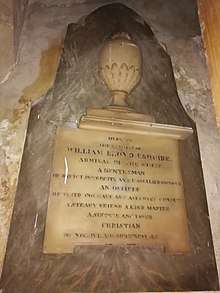William Lloyd (British Naval officer)
Admiral William Lloyd was from Carmarthenshire, Wales and became an Admiral of the White for the Royal Navy.[1][2] He sailed Governor Edward Cornwallis aboard HMS Sphinx to establish Halifax, Nova Scotia (1749).
William Lloyd | |
|---|---|
 | |
| Born | 28 June 1725 Dan yr allt, Llanelli, Carmarthenshire, Wales, UK |
| Died | 19 July 1796 (aged 71) Llangadog, Wales, UK |
| Allegiance | |
| Service/ | |
| Years of service | 1740–1796 |
| Rank | Admiral |
| Battles/wars | Seven Years' War
|
| Relations | Rachel Lloyd (Housekeeper) |
Naval career
His first command was of HMS Otter and HMS Invincible, which later sank and is a British heritage site.[3]
During the Seven Years' War, he commanded HMS Chesterfield at the Battle of Minorca (1756).[4] He also fought in the Action of April 5, 1757 when he commanded HMS Princess Louisa and the French fleet successfully evaded the British naval forces to arrive at Louisbourg.[5] Finally, he commanded HMS Conqueror at the Battle of Lagos (1759). In the battle, two of his crew were killed and six were wounded.[1] While still under Lloyd's command, the ship sank the following year off Drake's Island.[6][7]
After the war, Lloyd retired to the family estate in Carmarthenshire. He rose by seniority through the various flag ranks, eventually becoming Admiral of the White on 1 June 1795. He was buried at St Cadog's Church in Llangadog, Wales and a stone monument was mounted on the wall.
Real estate
In 1755, he was granted the power of attorney to receive rents from his father's estate.[8] In 1761 he was living in Hammersmith, Middlesex and inherited a large number of properties from his parents.[8][8] He contested the will of his relative Madame Bridget Bevan in 1779.[9]
Family
.png)
He was born in Dan yr allt (formerly Allt y meibion), Llanelli, Carmarthenshire to John Lloyd (1702–1728) and Mary Lloyd.[10][8] (When John died, Mary re-married Thomas Corbett of St Martin-in-the-Fields, esquire.)[8] William's sibilings Vaughan and Rachel are buried in Hammersmith Church. Along with William, neither sibling married or had children.[8] Rachel was a wealthy Housekeeper at Kensington Palace and a pastel artist.[11][12][13][14][15][16]
William died in 1796 and was buried in the St. Cadog's church along with his father John and grandfather Thomas, both of whom were High Sheriffs of Carmarthenshire.[17] William's father John created a monument in St. Cadog's church to his parents Thomas (d. 1720) and Rachel Lloyd (d.1702).[8] William's godchild John William Lloyd commissioned another monument in the St. Cadog's church for his son John Philipp Lloyd (d. 1849).[17][18][17]
His will is in the National Archives.[17][19] William divested the Dan y rallt estate to trustees for his kinsman Sir Thomas Stepney, 9th Baronet (d. 1825), the youngest son of Thomas Stepney of Llanelli, 7th baronet.[17][20] He also left part of his estate to his godchild John William Lloyd.[17][18]
Gallery
%2C_St._Cadog's_church%2C_Wales.png) Admiral William Lloyd's grandfather Thomas Lloyd (d.1720), St. Cadog's church, Wales
Admiral William Lloyd's grandfather Thomas Lloyd (d.1720), St. Cadog's church, Wales William's sister Rachel Lloyd - the Housekeeper, Kensington Palace, owned Cynghordy Estate in Carmarthenshire, Wales, UK
William's sister Rachel Lloyd - the Housekeeper, Kensington Palace, owned Cynghordy Estate in Carmarthenshire, Wales, UK Tomb of Admiral William Lloyd's godchild John William Lloyd, St Cadog's Church in Llangadog, Wales
Tomb of Admiral William Lloyd's godchild John William Lloyd, St Cadog's Church in Llangadog, Wales
References
- Clowes, W. Laird (William Laird); Markham, Clements R. (Clements Robert); Mahan, A. T. (Alfred Thayer); Wilson, Herbert Wrigley; Roosevelt, Theodore; Laughton, L. G. Carr (Leonard George Carr) (November 30, 1897). "The royal navy : a history from the earliest times to the present". London : S. Low, Marston and company, limited – via Internet Archive.
- Davies, J. D. (September 25, 2013). "Admiral William Lloyd (1725-96)".
- "The Gentleman's and London Magazine: Or Monthly Chronologer, 1741-1794". J. Exshaw. November 30, 1741 – via Google Books.
- "The trial of the Honourable Admiral John Byng". November 30, 1757 – via Google Books.
- "Action of April 5 1757, 5th April 1757". threedecks.org.
- "Royal Navy Wrecks". www.promare.co.uk.
- "Conqueror". www.promare.co.uk.
- "Cynghordy". November 30, 1962 – via Internet Archive.
- "BEVAN, BRIDGET ('Madam Bevan'; 1698 - 1779), philanthropist and educationist | Dictionary of Welsh Biography". biography.wales.
- "West Wales historical records. Annual magazine of the Historical Society of West Wales". Carmarthen, Printed by W. Spurrell and son. November 30, 1919 – via Internet Archive.
- "Niel Jeffares. Dictionary of Pastelist before 1800" (PDF).
- Palaces, Historic Royal (November 1, 2018). "The secrets of Kensington Palace". HRP Blogs.
- Kensington Palace: Art, Architecture and Society by Sebastian Edwards (Contributor), Joanna Marschner (Contributor), Deirdre Murphy (Contributor), Lee Prosser (Contributor), Olivia Fryman (Editor)
- Smollett, Tobias George. "The British Magazine, Or, Monthly Repository for Gentlemen & Ladies". James Rivington & James Fletcher ... & H. Payne – via Google Books.
- [file:///Users/todscott/Downloads/OldKewChiswickandKensington_10520846.pdf p.187]
- "Lloyd, Rachel (1722–1803), housekeeper | Oxford Dictionary of National Biography". www.oxforddnb.com. doi:10.1093/ref:odnb/9780198614128.001.0001/odnb-9780198614128-e-73545.
- Theakston, Lucy Ellen Lloyd (November 30, 1913). "Some family records & pedigrees of the Lloyds ." Oxford, Eng., Fox – via Internet Archive.
- "Cynghordy Muniments - Archives Hub". archiveshub.jisc.ac.uk.
- "Catalogue description: Will of William Lloyd, Admiral of the White of Danyrallt , Carmarthenshire". July 27, 1796 – via National Archive of the UK.
- "p.3" (PDF).
External links
![]()